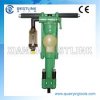Let'sgoflying!
Touchdown! Greaser!
I have about fifty 1&1/4" holes to drill into volcanic rock. (t-posts for a fence)
I can rent a hand held rock drill with a diesel-driven compressor to do the drilling.
Since I made this plan I hear a couple of local stories of the thing busting arms and hands so I am rethinking the project.
There is no one around to hire this out.
How to be safe about it?
If the bit binds in the hole, its like an electric drill except with a whole lot more torque. The drill motor starts to spin I'd presume and that's where the trouble starts. I looked at the drill and it's a T shape, with about a 20" handle on the top; ie 10" on each side of center.
I thought, 'I will put extensions on that and have two guys hold it' but I think even with six foot extensions they probably could not hold it and it would start spinning like a propeller, killing us.
Anyone ever used one of these things? What are some ways to stay safe? Don't they have an autoshut-off so that if it gets out of hand it pops off the pressure?
I can rent a hand held rock drill with a diesel-driven compressor to do the drilling.
Since I made this plan I hear a couple of local stories of the thing busting arms and hands so I am rethinking the project.
There is no one around to hire this out.
How to be safe about it?
If the bit binds in the hole, its like an electric drill except with a whole lot more torque. The drill motor starts to spin I'd presume and that's where the trouble starts. I looked at the drill and it's a T shape, with about a 20" handle on the top; ie 10" on each side of center.
I thought, 'I will put extensions on that and have two guys hold it' but I think even with six foot extensions they probably could not hold it and it would start spinning like a propeller, killing us.
Anyone ever used one of these things? What are some ways to stay safe? Don't they have an autoshut-off so that if it gets out of hand it pops off the pressure?




